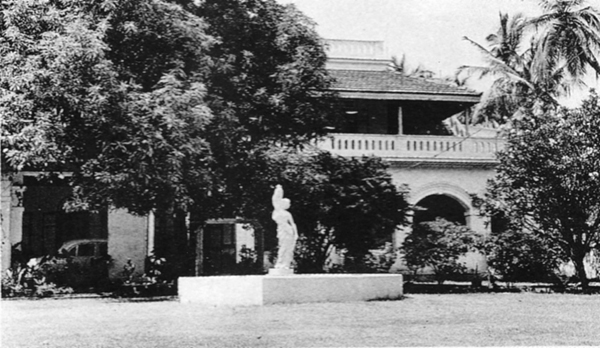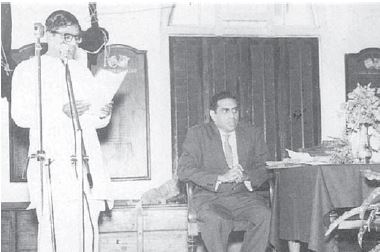|
Krishnaswami Alladi describes the story of the birth of MATSCIENCE, the Institute of Mathematical Sciences, the efforts of his father, Professor Alladi Ramakrishnan, and the role of his Theoretical Physics Seminar in the creation of this Institute in Madras on January 3, 1962.
(Continued from last fortnight)
In June 1958, a few of the new students in the MSc course started attending Father’s seminars at home. By July, Father was regularly giving seminars at home. All this was in addition to his lectures for the MSc course at Madras University where he was Reader in Physics. Many new students attended these seminars at his home, but the University took no cognisance of Father’s efforts. At that time, Madras University, led by Vice-Chancellor, Sir A. Lakshmanaswami Mudaliar, decided to open an extension centre in Madurai, and asked Father to shift to Madurai to start the Physics Department there. Several decades later, this extension centre became the Madurai University.

Ekamra Nivas.
Father was very upset at being asked to shift to Madurai, but agreed to do so. In his diary he recorded his reactions to this assignment in Madurai: “What really pained me was that the University took no cognisance of the valuable experience I gained at Princeton, where I had heard over 150 seminars by world-famous physicists, and I wanted to initiate work in high energy physics in a university which had among its alumni Raman, Ramanujan, and Chandrasekhar. The only reward for my enthusiasm was the modest compliment of banishing me as a professor to an extension centre. I found no alternative but to accept the professorship, since otherwise someone else would be appointed and would later wangle a transfer to Madras above my head.”
Ramakrishnan moved to Madurai and settled there without his family, but visited Madras frequently to be with them, and also to supervise his students who were in the MSc class. He wrote in his diary: “The University extension centre in Madurai was a mere name. It had neither buildings nor a library. It had neither body nor soul. The ill-furnished and crowded rooms at the colleges where I was asked to teach had a depressing effect since I had just returned after spending a year at the Institute for Advanced Study...”
An interesting opportunity arose unexpectedly. Ramakrishnan was invited to serve on a National Committee for Hindi terms in the physical sciences. Even though he did not know Hindi, he accepted the assignment because he could stop in Madras en route to Delhi for the frequent committee meetings. He adds in his diary: “I knew that money was available in India for such committees even though funds were denied for symposia and lectures! This would give me greater freedom of movement and the possibility of contact with higher authorities in Delhi whose attention I could draw to my vision and efforts in Madras.” He also found it convenient that Madras University allowed him to conduct the MSc course in theoretical physics in Madras (it was for the first batch) during specific periods of the academic year 1958-59.
It was while in Madurai that Prof. Ramakrishnan wrote to Sir C.V. Raman offering to organise a session on stochastic processes at the Indian Academy of Sciences meeting in Baroda in December 1958. Sir Raman agreed to the request, but suggested that the lectures should be of wide appeal and emphasise the relationship between theory and experiment. Father was able to take several of his research students to the Baroda meeting and have them give lectures on their work. It was a great experience for them to speak in the dominating presence of Sir Raman in the front row!
* * *
In 1959 Father was holding his regular MSc Physics classes in a room in Senate House and conducting his informal but advanced seminars at home. Since these seminars had become a regular feature supplementing the MSc course, he decided to formalise the practice in March 1959 and called the programme the ‘Theoretical Physics Seminar’. V. Devanathan, one of his most dedicated MSc students, was made the Secretary of the Seminar. It was decided to invite eminent scientists visiting or travelling through India to speak at the Seminar.
The first visitors after the formal launch of the Theoretical Physics Seminar were Professor Ziro Koba, whom father had met during his visit to Yukawa Hall in 1956, and Dr. Kotani. Professor and Mrs. Kotani stayed at Ekamra Nivas and therefore had leisurely discussions with Father and his students. In addition to exposing his students to lectures by foreign visitors at the Seminar, Prof. Ramakrishnan also took his students regularly to participate and lecture in conferences and summer schools which were held in various parts of India. After a Summer School on Theoretical Physics held in Mussoorie in June 1959, to which he took four students, he wrote, “The moving spirit of the summer school was Satyen Bose, the doyen of theoretical physics in India, and very sympathetic to the aspirations of the young scientific community. He was more interested in stimulating creative thought than in expository talks at the conference... In my speech I exhorted that the Mussoorie spirit should pervade Indian science in due course.”
In August, Father received an invitation from the University Grants Commission to serve on an Expert Committee to recommend proposals for the advancement of mathematical sciences in India. It was indeed ironic to be appointed to this Committee when his efforts to initiate advanced physics in Madras were ignored by the University!
* * *
A turning point in Prof. Ramakrishnan’s life was his unexpected meeting with C. Subramaniam in October 1959 and the Minister’s visit to the Ekamra Nivas shortly thereafter to meet the students of the Seminar. Recalling the meeting Prof. Ramakrishnan wrote, “During the Dasara season of 1959, I received an invitation to an international gathering of African and Asian students at Woodlands Hotel with C. Subramaniam as their Chief Guest. He was then the Minister for Education and Finance in the Madras Government. I knew of him and had met him in New Delhi during the momentous days of the Constituent Assembly when he was a blackhaired young Congressman who came to have discussions with my father (Sir Alladi Krishnaswamy Iyengar). But I did not know him personally. I did not feel enthusiastic about going to the meeting since I felt that he may not have a real interest in higher education or creative science. So, that evening I decided to go and relax at the Marina beach with my wife Lalitha. As the car was about to take a turn towards the beach, she suggested that we should respond to the invitation and attend the meeting for at least half an hour, to which I consented most unwillingly.

C. Subramaniam at Ekamra Nivas with Prof. Ramakrishnan.
“At the meeting, one of the topics that came up for discussion was about racial prejudice and how these students should tackle this in India... When I was asked to give my views, I stressed that racial prejudice or prejudice in any form is best tackled by demonstration of good performance. Such snobbery exists even in the realm of science and in many professions. When my father started his legal profession (in Madras), he was warned that it would be difficult to succeed unless one had tasted the waters of the Cauvery. But within seven years, with hard work and dedication, he became the unrivalled leader of the Madras Bar and had several juniors who hailed from the banks of that famous river! Similarly, in modern physics, while it was generally agreed that Europe was the seat of science and culture, with the efforts of Oppenheimer and the new generation of scientists, the centre of gravity shifted to the United States.
“This speech of mine impressed Subramaniam so much that he asked me to meet him at his official residence, Cooum House. I wasted no time and emphasised to him the need for providing suitable opportunities to the band of theoretical physicists working with me. I invited him to dinner at my house to which he readily responded. It was at that dinner he suddenly asked me to explain what I meant by suitable opportunities for creative science. I told him plainly that it was something like the Institute for Advanced Study in Princeton.” The Minister asked for a note on how the new institute could be launched. During the years 1960 and ’61, several world-famous scientists spoke at the Theoretical Physics Seminar and Minister C. Subramaniam came to Ekamra Nivas on many occasions to meet the visiting scientists and have discussions with them over dinner.
* * *
The years 1960 and 1961 were packed with the lectures of many world-famous physicists and mathematicians at the Seminar. The year started with the visits of physicist Abdus Salam of Imperial College, London, and Niels Bohr, both of which had a profound influence on the creation of MATSCIENCE and on Father’s career.
Professor Salam spent a few days in Ekamra Nivas and at his two-hour lecture there he was thrilled to find such an eager and enthusiastic audience. Following dinner he relaxed with the students on the lawns of Ekamra Nivas. Father presented Salam with a portrait of Lord Krishna which he graciously accepted. In return, Father expressed his thanks by attending Namas with Prof. Salam at a mosque in Madras!
Salam’s visit was immediately followed by that of Nobel Laureate Niels Bohr who was in India in January 1960 as the guest of Prime Minister Nehru. Professor Bohr accepted Father’s invitation to visit Ekamra Nivas and meet the students of the Seminar. He was staying at Government House, but agreed to have dinner at Ekamra Nivas and spend a leisurely evening with the students. Father later wrote in his diary: “It was flattering that Professor Bohr and his wife stayed on until midnight in spite of repeated reminders from the official aide to get back to Government House. Mrs. Bohr, a gracious woman of great charm and elegance, kept a watchful eye to prevent her husband from putting his burning pipe into his coat pocket! We could not believe that such a great physicist, engrossed in his own thoughts who, along with Einstein, set in motion the atomic age, could evince interest in a group of stripling physicists in a far off country. He did so in a generous measure at a press interview at the airport which was reported in The Hindu as follows:
Asked about the place mathematics should occupy in the pursuit of theoretical physics, the professor said that in Bombay and in Madras efforts were being made for the promotion of knowledge of physics which demanded new mathematical methods and the training of young people to be able fruitfully to contribute to such work. Wonderful work was being done in the field of theoretical physics by Professor Alladi Ramakrishnan of the Madras University.
“He seems to have mentioned this to the Prime Minister when he met him before leaving India.”
Prof. Ramakrishnan, not long afterwards, received a communication from the Prime Minister’s Office asking for further information about his efforts in Madras. It was to take nearly two years before this interest from the Prime Minister’s Office would lead to the creation of MATSCIENCE.
With the endorsement given by Professor Bohr, Father wrote to the Vice-Chancellor that it would be impossible for him to continue the assignment in Madurai. He had received an invitation to visit the University of Berne, Switzerland, for two months. In the same letter, he requested the Vice-Chancellor for two months’ leave to visit Europe. The University sanctioned the leave and reluctantly agreed to relieve him of the assignment in Madurai, stating that he should return to Madras after the Swiss assignment and serve as “Professor without portfolio”.
(To be continued)
|

